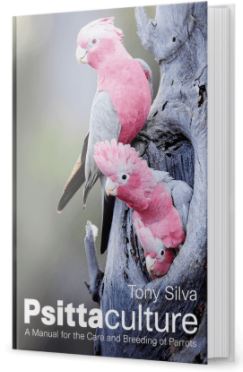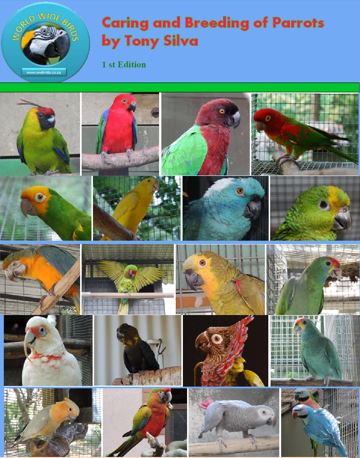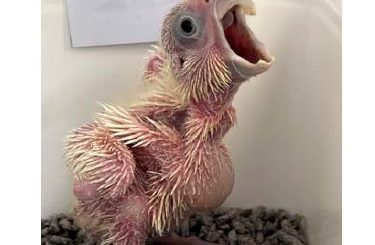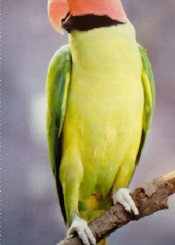Parrot medication
We asked Tony Silva about parrot medication.

“When should we medicate our birds?” By Tony Silva
Parrot medication introduction
As I travel the world, I see dramatic differences in husbandry protocols. In Europe, there is great adversity to using medications on parrots. In contrast, in Asia some believe that medication should be used as part of the husbandry, subjecting the birds to regular courses of medications. I disagree with both principals. Medications should never be abused, as they can cause far more problems than they are intended to solve. A sick bird, on the other hand, needs aggressive therapy in order to keep its health from deteriorating to the point that it will not recover. The question of when antibiotics and the concomitant antifungals should be used is in my opinion very clear: when they are actually needed and never prophylactically.
Parrots are notorious for hiding an illness. They are in the main flocking animals. In the wild a sick bird in a flock attracts the attention of predators. This is why they hide their deteriorating health until it is usually too late. These birds then separate from the flock. In most cases, they are taken by predators long before they succumb to the illness.
Parrot medication in a captive environment
In a captive environment, the sick bird will mask its illness, but a keen aviculturist will immediately notice a change in behavior: the bird will not be as active or vocal, may not descend to feed when fresh food is offered and may remain with feathers fluffed in a secure part of the aviary. The bird will also not play or preen. Such a bird will clearly need medication. Its illness makes it clinically ill.
Parrots can also be subclinically ill. They may behave normally but their illness may cause them not to breed or may cause infertility, embryo loss, and chick mortality. Chlamydia psittaci or parrot fever is a typical case in point. Some birds are subclinical. They appear healthy but are infected and display the illness only when stressed. This condition can cause infertility, early embryo death, or even the death of the chick shortly after hatching.
All parrots should be treated only based on an acute knowledge of medications and their application. You simply cannot buy an antimicrobial agent and treat the bird. Treatment should be based on empirical data—what is the antibiotic that has worked best to address those illnesses that are most common in the collection—or on culture results. In both cases, an avian veterinarian should be consulted, though in areas where they are not available any veterinarian can culture a swab and identify the best antibiotic to use. The cultures identify the agent causing the illness and also the best antibiotic to be used for combatting that agent. This is pure science. With a parrot that can die in a few days from the onset of illness, guessing is a dangerous game.
In breeding collection
In a breeding collection, I recommend conducting spot physical exams when birds have to be caught for any reason. Look at the eyes, inside the mouth, the nare openings, the vent, and the body. A bird that is thin and has mucous or a sour odor emanating from its mouth will need further review. It is likely suffering from bacterial and fungal infections. This bird will need to be examined by a veterinarian. Stained vent feathers may suggest an internal parasite infection, which will need treatment; parasites like disease can also stint breeding.
Birds that fail to nest or consistently produce clear eggs, eggs that die during early incubation, or chicks that regularly die should be suspected of being subclinically ill. These birds should be examined in detail and the prerequisite cultures performed. I do not like to culture birds from droppings collected from the aviary floor, as these samples are probably contaminated. Rather I prefer to take a choanal swab; the choana is the slit in the roof of the mouth; it has rows of fine hairs that glow along the slit, these hairs becoming worn if there is a bacterial or fungal infection and are a good gauge as to the health status of a bird.
The culture results will likely produce a pathogen and the sensitivities will reveal the best course of action. On being treated, these birds often become productive. When I provide consulting, this is the first area I examine. Often culturing and treating with the proper medication can make a collection go from producing virtually no young to being very productive.
Pairs that were productive and suddenly stop nesting or commenced producing infertile eggs should also be examined. Find that in almost all of these cases some low-grade infection is involved. On being treated, the birds again breed successfully.
I do not believe that the entire collection should be subjected to a yearly medical exam. This causes undue stress on the birds. Instead, I believe that the birds should be examined when they are caught or if they are not breeding successfully. If a pair never nests and they have been given the proper conditions for breeding—a good, balanced, and nutritious diet, the proper nest, the correct photoperiod, and more—then I would also subject them to a physical exam and culture.
By incorporating science and the aid of a veterinarian, the breeder can be far more successful. The additional young will more than compensate for the effort and expense of maintaining flock health.
Tony’s book Psittaculture, is available from:

This article, parrot medication, and ALL TONY’S ARTICLES IS AVAILABLE IN THIS eBook, available to subscribers only.
Click on cover to see what you receive for subscribing:




